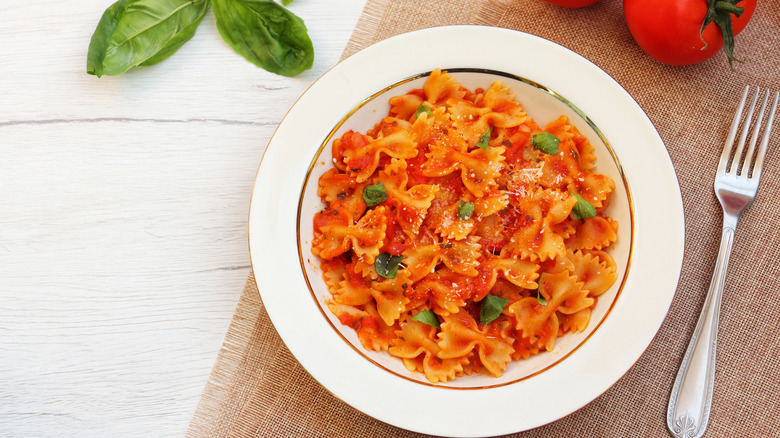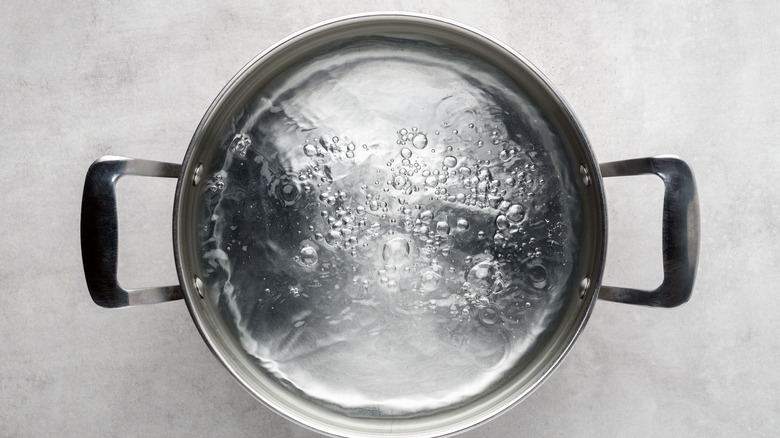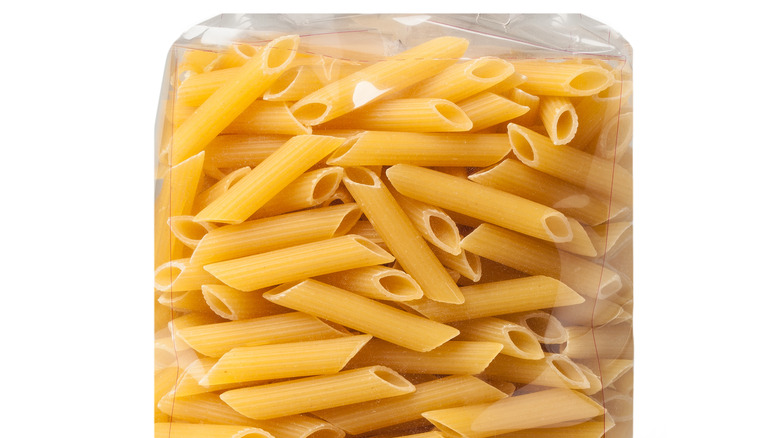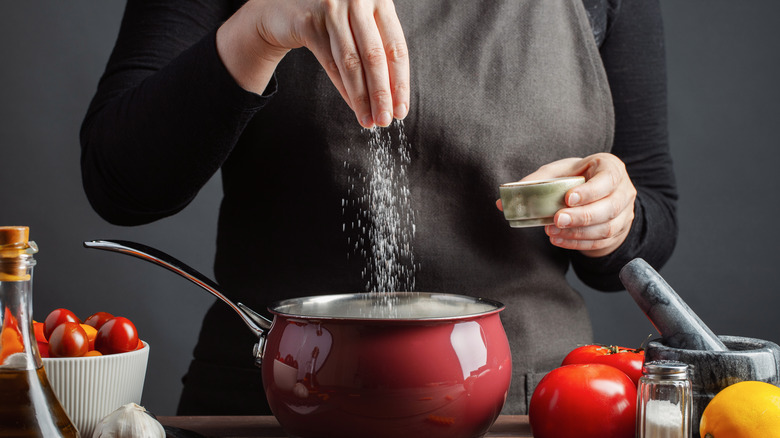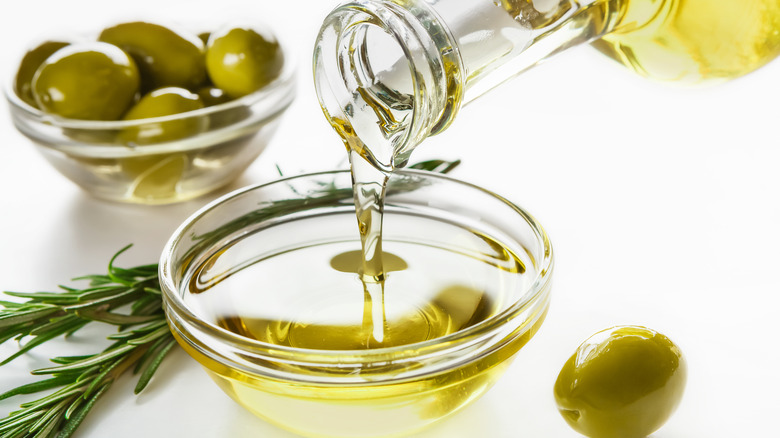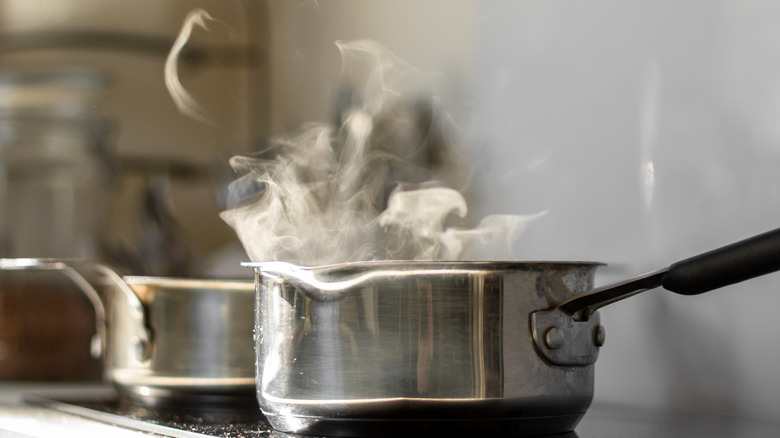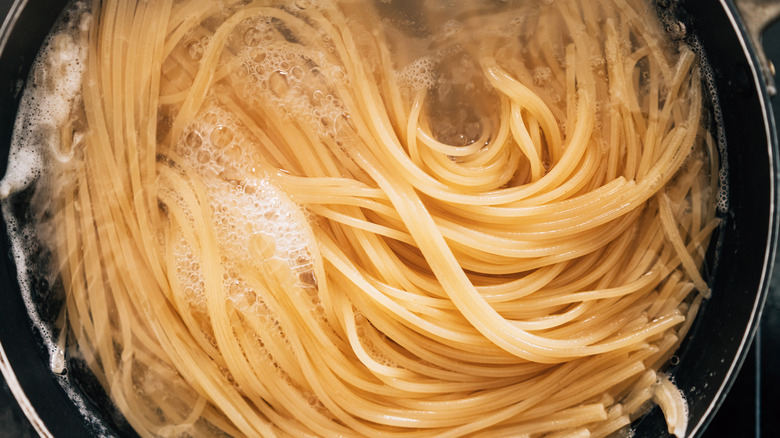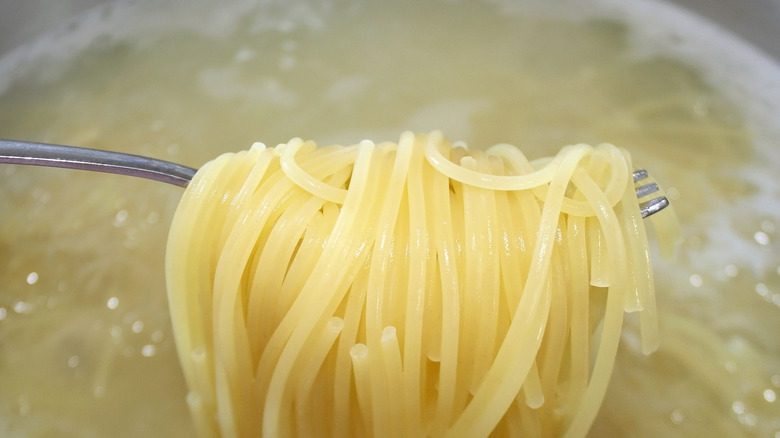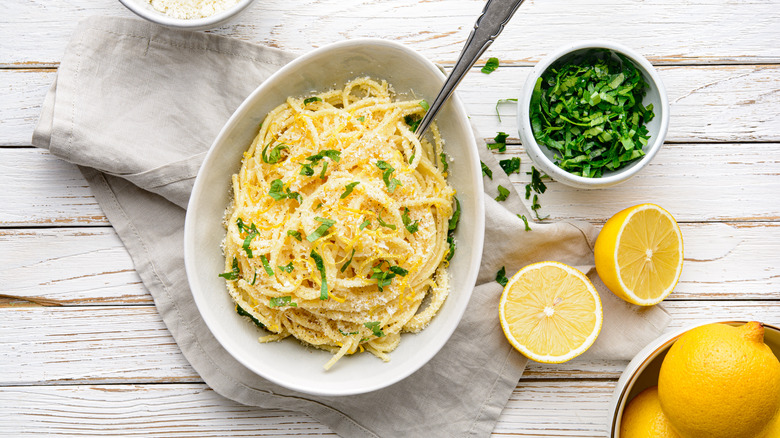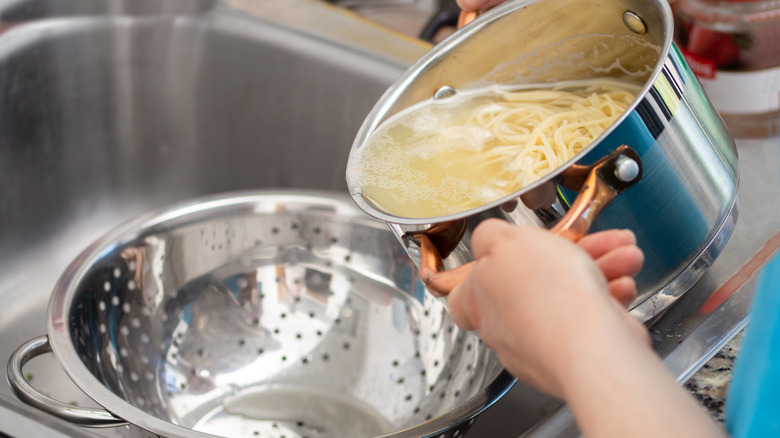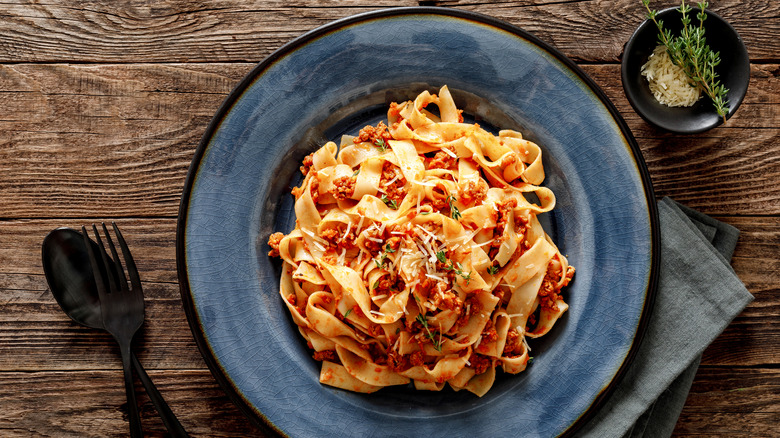How To Make Perfect Pasta Every Single Time
There's few foods that are as warm and comforting as a heaping bowl of delicious pasta. And while pasta does come in endless shapes and varieties — from spaghetti to ziti to shells and many in between — and can be tossed with sauce, baked with cheese, or enjoyed with all sorts of various vegetables and proteins, there's undeniably some pastas that are simply more enjoyable than others.
Of course the sauces and toppings do matter, but the process starts with when that pasta is prepped. Everything from the pot you use to boil the water, to how salty the water is (think of the ocean!), to the cooking time and method will make a big difference in the final result.
Pasta is special, and there's so many ways to enjoy it. But follow these pasta cooking tips from the experts themselves, and your pasta will be such a hit that your guests will rush back for seconds.
Make sure you use a large enough pot
While it may seem like any pot will do when boiling pasta, the size of the pot actually does matter. And not every pasta dinner will require the same size pot, either!
The actual size of pot needed will ultimately depend on the size of the pasta and the amount that's being cooked, but this is an important consideration that's easy to forget. "Much like not crowding the pan when making protein or roasting vegetables, pasta cooks best if the hot water can circulate around the pieces," Jessica Formicola from Savory Experiments told Mashed.
It's all about size and capacity. The pot has to be big enough to fit all the past being cooked and also deep enough that when the boiling begins, the pot will not overflow. If the water is at a rolling boil and you realize if you add pasta, it will overflow — and that isn't good.
"Pasta expands in size, so make sure you account for that," said Formicola. It's fairly hard to have a pot that's too big for your pasta, but it is easy to have a pot that's too small. And, of course, once you are using that pot, do make sure you have enough water in there to cover all the pasta you throw inside.
Check the pasta package for proper timing
Pasta comes in a wide array of shapes and sizes. Different sizes, shapes, and densities of pasta may require longer or shorter amounts of cooking time. That is why it's important to check the package for the suggested cooking time to ensure the specific type of pasta you're making reaches the al dente stage rather than getting overcooked.
"The different sizes and shapes of pasta dictate their specific cooking times, with some pasta shapes being denser or thicker and therefore requiring longer than others," Kelly Senyei, author of "The Secret Ingredient Cookbook" and founder of Just a Taste, told Mashed. For example: "Angel hair pasta will cook much faster than spaghetti or bucatini because it's a much thinner noodle so it requires less time to reach the al dente stage," said Senyei.
Pairing noodles with sauces can be an art: When preparing pasta, try to consider both the thickness and flavor of your sauce when choosing a noodle. For example, a hearty Bolognese is best served with a sturdy noodle that can withstand the weight of the thicker sauce, said Senyei.
You need lots of salt when boiling pasta
A common mistake people make with pasta is not salting the water enough. In fact, our experts say that water needs a lot of salt. "Our French chef in cooking school always admonished us with a stern 'Zee water must taste like zee sea'... Really, he talked that way," chef and sommelier Laura Pauli told Mashed. Translation: Add more salt. "At least two tablespoons of kosher salt per gallon. If I'm feeling particularly salty, I'll use at least three," said Pauli.
Plain pasta has very little flavor on its own. But when cooking, that could be a good thing because that makes pasta a blank canvas, so every opportunity to up its flavor with seasoning should be fully embraced. It's essential to boil your pasta—whether it's fresh or dried—in water that's as salty as the sea. "This starts building the flavor of the pasta and ensures it'll be at its tasty peak no matter what sauce you toss it with," Kelly Senyei, author of "The Secret Ingredient Cookbook," told Mashed . So, don't hesitate to be heavy-handed with the salt!
And remember, not all salt is the same salt. Coarse kosher salt, fine salt and iodized salt are not created equal: "If a recipe calls for coarse salt and you only have a fine salt, cut the amount in half or it will be way too salty," said Jessica Formicola from Savory Experiments.
Do not add oil to the boiling water
In general, oil can be an asset when cooking — but this is not always true. Making the perfect pasta does not require adding oil to the water. This is a common rookie mistake, and actually will take away from the final results of the dish. "People want to add oil so their past doesn't stick, but this added oil is detrimental to the final product," Chef Anja Wolf, the CEO of the cookware website I Love Cookware!, told Mashed. "After you drain the oil-coated pasta, the sauce will not stick to the noodles correctly," said Wolf.
Kelly Senyei of Just a Taste agrees that while salting pasta water is a must, adding oil should be avoided. "It's a common misconception that adding oil to pasta water will prevent the noodles from sticking together, however, the oil actually creates a slick surface on the pasta, which makes it difficult for any sauce to stick," Senyei. told Mashed. Ditch the oil and keep your noodles from sticking together by stirring the pasta as soon as you drop it into the boiling water instead.
In summary, don't make the mistake of adding oil to the boiling water — not only is it unnecessary, you'll also get a more flavorful pasta dish with sauce that clings to the noodles by not doing so.
Make sure water is boiling before you add the pasta
Sometimes people become impatient and add the pasta to the water before it's truly boiling. "This is a no-no because when you add pasta to hot, but not boiling water, it immediately begins to release starch," Nino Zizzo, Executive Chef of the San Diego-based Busalacchi Restaurants (Barbusa and Nonna), told Mashed. "When the starch is released too soon, the result is pasta that's mushy on the outside, and undercooked and hard on the inside."
As you might already know, when cooking pasta, timing is everything, but that can depend on type of pasta, so don't use the same method for all kinds. "Don't add it to the water until it's reached a rapid boil and factor in the type of pasta it is when timing. Fresh pastas cook a lot faster than dried pastas," Executive Chef Kris Toliao, of Cassava in San Francisco, told Mashed.
So, rule of thumb: Always be sure to wait until the water is boiling, and heed the instructions provided, to ensure that your pasta is cooked evenly.
Your pasta should be cooked until it's al dente
Most people know that the ideal texture for pasta is al dente, or "firm to the bite," but that doesn't mean we actually do cook pasta al dente, or know the way to do so. "The old trick of throwing pasta against the wall to see if it's done doesn't actually work," Nino Zizzo, Executive Chef of Busalacchi Restaurants in San Diego, told mashed. I
Instead, advises Zizzo, the trick you want to try is to take a bite of your pasta and check if it still has a bit of white in the middle. If it does, that means it's perfectly al dente. "You want to make sure you stop cooking it then, because when you add hot pasta to hot sauce, it continues to cook, and if you cook the pasta completely before adding the sauce, it will end up overcooked once the sauce is added," Zizzo advised.
Another reason this trick is great? It means you get an early taste of your pasta!
Always save some pasta cooking water
Pasta water contains both starch and salt, making it a very flavorful and useful liquid when it comes time to sauce your noodles. "The starch acts as a binding agent while the salt helps season the noodles from the inside out, so the resulting water contains that same rich flavor," Kelly Senyei, author of "The Secret Ingredient Cookbook," said to Mashed.
Once your pasta has cooked to your desired doneness, reserve some of the cooking water. "The starchy, salty liquid is the secret to restaurant-worthy pasta in your home kitchen," Senyei advised. "Use it to help emulsify the cheesy butter sauce when making classic cacio e pepe, or stir it into your noodles and pesto to help thin the mixture."
The method of using this starchy water as a cooking ingredient is actually rather simple. "Add one to two ladles of the starchy pasta cooking water to your pasta sauce and reduce," Devan Cameron, chef and owner of Braised & Deglazed, a recipe and food inspiration website, told Mashed.
The starch in the pasta water brings the sauce together nicely and helps to thicken it slightly. Just be careful not to add too much, said Cameron, because the water is salty, after all, and it can over season your finished sauce.
Add the cheese and butter at the end
Cheese does indeed make many dishes even richer and more satisfying, and pasta is no exception. However, as with other foods, timing is indeed everything if you are going to start adding touches to your pasta. When it comes to cheese or butter, they're best as a finishing touch; finish your pasta with these ingredients at the end to get a creamy, emulsified sauce. "This process known in Italian as mantecatur [and] is the secret to a creamy risotto without actual cream," said Devan Cameron, chef and owner of Braised & Deglazed, to Mashed.
In a great pasta, the various ingredients will work together to create a perfect result. For example, the starchy pasta water added to a pasta sauce will help to emulsify the cheese and butter and result in one beautifully creamy pasta. "To use this technique properly, simply add the cold butter and cheese to your pasta sauce at the end and off the heat," Cameron added. Don't forget to stir vigorously — you want all that goodness to be well mixed!
Don't rinse your cooked pasta
Once the pasta is drained, do not give into that impulse you may have to add cold water to cool that pasta down. Instead, add the pasta to your favorite sauce, straight into the skillet, to cook for an additional few minutes.
Some people make an error by adding cold water to the pasta. "This rinses off the salt and starches from the pasta," Chef Anthony Russo, Founder and Chef at Russo's New York Pizzeria and Italian Kitchen, told Mashed.
But if for some reason you do need to cool your pasta, Russo would add in extra-virgin olive oil, move the pasta from the cooking pot to another container, and place that container over a tray of ice. "This way it will cool down without losing the starches and salt," said Russo. After that, place the pasta in any container and put it away in the cooler or fridge for next day use. The pasta will stay al dente.
The best bet is to finish the pasta in the sauce
When you see chefs flipping hot pans of pasta in the air it's not just for show. "Just like a risotto, a pasta needs to be stirred and flipped vigorously at the end to release the starch into the sauce," Devan Cameron of Braised & Deglazed told Mashed.
So, once the pasta is in the pan, flip it in the pan to release the starch before serving it. Nothing is more frustrating than seeing a plate of oily pasta underneath a pile of sauce sitting on its own. "Pasta needs to be finished in the sauce for one to two minutes to allow the flavor to soak into the noodles," said Cameron. That's why day-old pasta tastes so good, because the sauce has effectively flavored the pasta.
In summary, don't divorce the pasta from the sauce — they're soulmates and must be one. "Pull the pasta one to two minutes earlier from the cooking water and finish cooking in your flavorful pasta sauce," advised Cameron.
